Main menu
Common skin conditions

NEWS
Join DermNet PRO
Read more
Quick links
Periorificial dermatitis — extra information
Periorificial dermatitis
Author(s): Dr Nayab Shah, Royal Perth Hospital, Australia. Copy edited by Gus Mitchell. July 2022
Introduction
Demographics
Causes
Clinical features
Complications
Diagnosis
Differential diagnoses
Treatment
Outcome
What is periorificial dermatitis?
Periorificial dermatitis (POD) is a relatively common chronic inflammatory skin eruption. It preferentially targets cutaneous orifices as implied in its name ie, around the eyes, nostrils, mouth, and occasionally the genitals.
Periorificial dermatitis may be limited to a single orifice, where it is more appropriately termed:
- Perioral dermatitis (classic site affected)
- Periocular dermatitis
- Perinasal dermatitis
- Genital periorificial dermatitis (involving the labia majora, scrotum or anus).
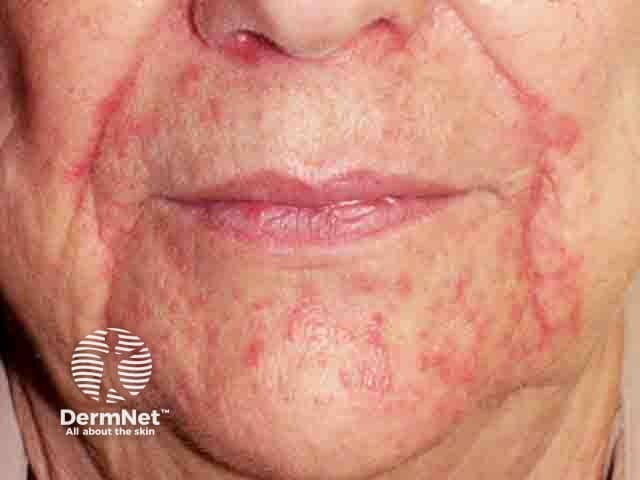
Perioral erythematous papules sparing the immediate perivermillion skin in perioral dermatitis
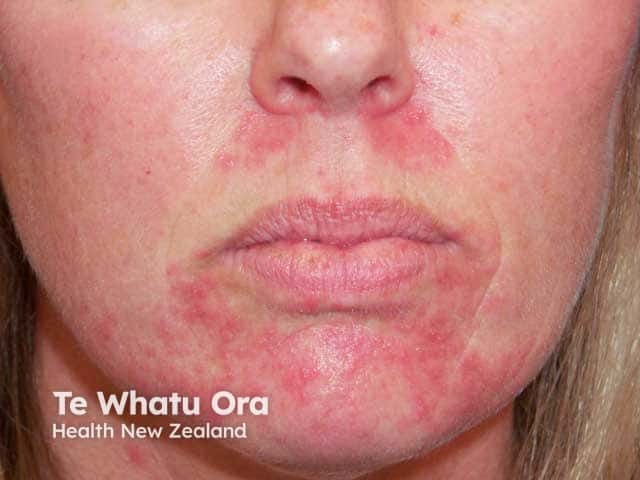
Perioral and nasolabial fold papules sparing the perivermillion skin in perioral dermatitis

Perioral dermatitis

Periocular dermatitis

Perioral dermatitis
Who gets periorificial dermatitis?
Periorificial dermatitis is slightly more common in lighter-skinned females and usually affects young to middle-aged women (20–45 years). However, it is also seen in young children, often between 7 months to 13 years old.
The exact incidence and prevalence remain unknown.
What causes periorificial dermatitis?
The exact cause is not understood. A suggested mechanism proposes epidermal dysfunction as the primary disturbance, resulting in:
- Increased penetration of exogenous agents through the stratum corneum, triggering an irritation reaction
- Enhancing trans-epidermal water loss resulting in tightness and dryness, causing patients to increase use of topical products, leading to further irritation.
Risk factors associated with POD
- Steroid use via all routes (topical, inhaled, nasal insufflation) is the most common association. Application may be accidental (eg, nasal sprays) or intentional.
- Cosmetic use.
- Epidermal barrier dysfunction secondary to:
- Nutritional deficiencies eg, zinc deficiency
- Occlusive emollient use leading to overhydration eg, paraffin or petroleum-based emollients
- Sunscreen use, particularly physical sunscreens in children.
- Allergens/irritants eg, toothpaste and dental fillings.
- Infective organisms such as Demodex spp., Candida albicans, and fusiform bacteria have been cultured from lesions, however, their significance remains unclear.
- Hormonal changes caused by oral contraceptive use, pregnancy, and premenstrual flares have been observed.
- Atopic predisposition.
Physical factors including UV light, heat, and wind seem to worsen periorificial dermatitis.
What are the clinical features of periorificial dermatitis?
Cutaneous features of periorificial dermatitis include:
- An acneiform eruption
- Clusters of skin-coloured to red papules, vesicles, and pustules
- Usually less than 2mm each; may coalesce into larger lesions
- Erythematous base with a sharp border
- Surrounding skin is often dry
- Scaly and flaky skin surface
- Burning sensation or skin tightness
- Itch.
Pain is rare, although skin sensitivity is common and patients are otherwise systemically well.
Whilst usually limited to the affected orifice, more severe POD may extend to the chin, cheeks, lateral lower eyelids, upper eyelids, forehead, and glabella. The immediate peri-vermillion skin is often spared, only rarely is it affected in severe cases.
Topical steroids can obscure the primary rash and may also result in steroid-induced cutaneous side effects.
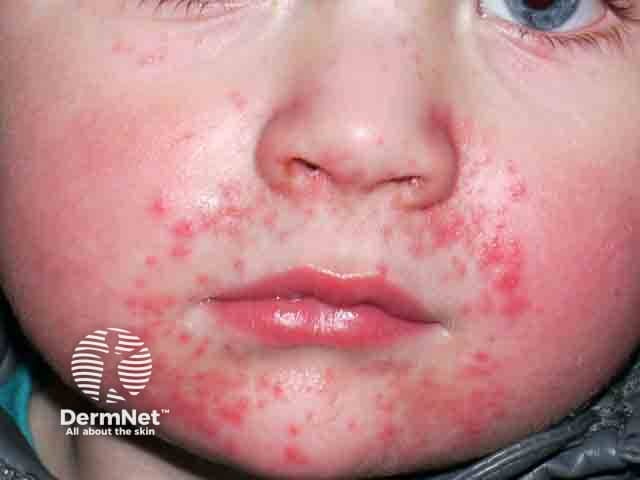
Perioral dermatitis due to the use of a steroid nebuliser mask
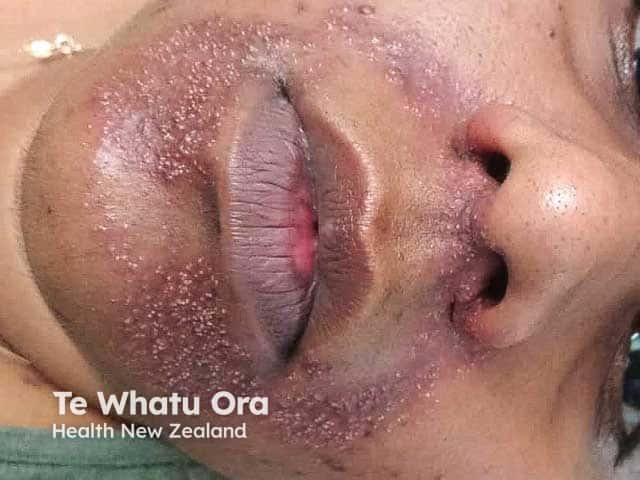
Papules and pustules (an unusual feature) in perioral dermatitis
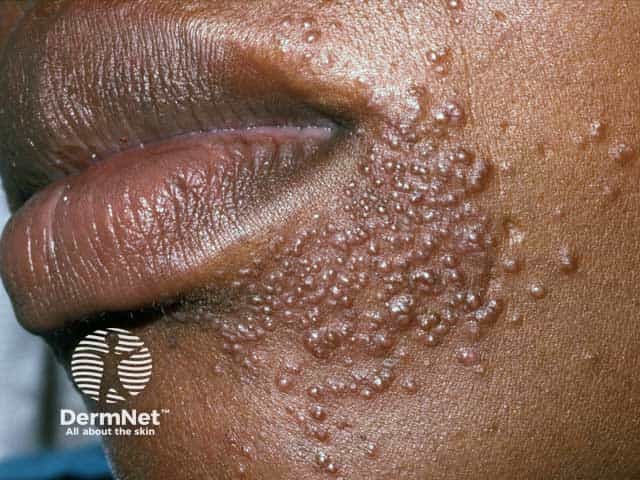
Florid perioral dermatitis due to potent topical steroid use
Lupoid perioral dermatitis
This is a severe subtype of POD. Eruptions are denser and larger with red-brown papules. The affected skin shows lupoid infiltrates, with a characteristic apple-jelly colour on diascopy. This subtype can result in permanent scarring.
Childhood granulomatous perioral dermatitis (CGPD)
CGPD is a rare variant often seen in children with dark-coloured skin. It was previously termed FACE (Facial Afro-Caribbean Childhood Eruption). However, it has since been renamed as it has been observed in children with light-colour skin and those not of Afro-Caribbean heritage.
Patients present with skin-coloured, red or yellow-brown monomorphic, dome-shaped papules. There is typically a lack of pustules and vesicles in CGPD, and erythema and scaling are less prominent than in classic POD. Additionally, the histological features between CGPD and POD are different.
Extra-orificial skin can also be affected with an eruption on the neck, chest, and extremities, in addition to conjunctivitis and blepharitis.
What are the complications of periorificial dermatitis?
- Granulomatous periorificial dermatitis — a variant of periorificial dermatitis that presents with persistent yellowish papules.
- Occurs mainly in young children and nearly always follows the use of a corticosteroid.
- Granulomatous perifollicular infiltrate on histopathology.
- Steroid rosacea presents with steroid-induced, large facial papules, papulopustules, and telangiectasia on the mid-face, including forehead and cheeks.
- Rebound flare of severe periorificial dermatitis may occur after abrupt cessation of potent topical steroid to facial skin.
- Psychological distress.
How is periorificial dermatitis diagnosed?
POD is a clinical diagnosis. Other investigations that may be used are:
- Swabs and skin scrapings for culture and potassium hydroxide (KOH) testing to exclude bacterial and fungal infections.
- Patch testing to test for allergic contact dermatitis.
-
Skin biopsy where there is diagnostic uncertainty and may reveal:
- Perivascular and perifollicular inflammation with oedema and lymphocytic infiltrates
- Epidermal spongiosis
- Follicular abscesses in severe cases.
CGPD characteristically shows perifollicular and upper dermal tissue containing noncaseating granulomas surrounded by lymphocytes and often giant cells. Again, epidermal spongiosis may be present.
What is the differential diagnosis for periorificial dermatitis?
Differential diagnosis depends on the site(s) involved.
Facial POD
- Rosacea — patients are often older, distribution is different, and rosacea-associated complications such as rhinophyma are absent
- Acne — comedones, nodules, and cysts present which are not typical of POD
- Seborrheic dermatitis — different distribution including involvement of frontal hairline, scalp, and presternally.
- Contact dermatitis — allergic and irritant (pruritus is often more intense)
- Lip licker's dermatitis
- Impetigo.
CGPD
What is the treatment for periorificial dermatitis?
Periorificial dermatitis is a benign self-limiting condition with no systemic consequences. However, it may be cosmetically unacceptable to the patient, resulting in significant disease burden and psychological distress. Periorificial dermatitis usually responds well to treatments.
The POD Severity Index (PODSI) has been used in literature to help quantify disease severity and response to treatment.
General measures
The zero-therapy approach should be utilised in all POD patients and may result in complete resolution of mild cases. Advise patients to:
- Stop all facial cosmetics and topical products, including sunscreens and emollients
- Preferably wash the face with warm water alone until the rash clears, then consider a non-soap cleanser
- A bland emollient without preservatives/additives can be used for skin dryness. Avoid occlusive creams and ointments as they can worsen POD.
- A gel or liquid sunscreen can be used
- Discontinue all topical corticosteroids
- Slowly wean steroids over weeks, switching to a lower potency steroid before cessation and substituting with topical pimecrolimus
- Tacrolimus is an alternative but has less evidence
- A flare may occur on discontinuation — steroids should not be restarted.
Medically necessary nasal, inhaled, and oral steroids should be continued but will increase recovery time. Rinsing the face and mouth after using nasal or inhaled agents may help.
Specific measures
Topical and/or systemic treatments are available; duration is usually 4–8 weeks but may require an extension. Recurrence can occur if treatment is too short.
Topical agents
- Metronidazole 0.75–1%
- Erythromycin 1%
- Pimecrolimus 1% twice daily for up to 4 weeks
Topical treatments are often not tolerated due to associated facial sensitivity; if they are, they may be rotated every 6–8 weeks if the patient fails to respond.
Other topical therapies have limited evidence supporting efficacy and safety. These include:
- Azelaic acid
- Clindamycin
- Tacrolimus
- Adapalene
- Sulfacetamide/sulfur
- Photodynamic therapy.
Systemic therapies
- Tetracycline — recommended first-line, and the response is usually quick
-
Erythromycin — first-line for pregnant women and children under 8 years
- Azithromycin is an alternative.
Sub-antimicrobial doses may be effective for some patients. In cases resistant to systemic therapy, a combination of oral and topical therapy may be considered.
- Isotretinoin — low-level evidence for refractory cases.
- Cefcapene pivoxil hydrochloride — limited evidence for efficacy and safety.
What is the outcome for periorificial dermatitis?
Periorificial dermatitis, including CGPD, often runs a chronic variable course that may last months to years without treatment. Usually, there is no scarring or disturbance to skin pigmentation except in severe and lupoid cases.
With treatment, most patients recover well. If POD recurs when antibiotics are discontinued, or in the future, the same treatment can be used again.
Bibliography
- Gray NA, Tod B, Rohwer A, Fincham L, Visser WI, McCaul M. Pharmacological interventions for periorificial (perioral) dermatitis in children and adults: a systematic review. J Eur Acad Dermatol Venereol. 2022;36(3):380–90. doi: 10.1111/jdv.17817. PubMed
- Kim Yoon Jee, Jung Woong Shin, Jong Suk Lee, Young-Lip Park, Kyu Uang Whang and Sung Yul Lee. “C.” Annals of Dermatology 23 (2011): 386–8. PubMed Central
- Lipozenčić J, Hadžavdić, S.L. Perioral dermatitis. Clin Dermatol. 2014 Jan-Feb;32(1):125–30. doi: 10.1016/j.clindermatol.2013.05.034. Journal
- Searle T, Ali FR, Al-Niaimi F. Perioral dermatitis: Diagnosis, proposed etiologies, and management. J Cosmet Dermatol. 2021 Dec;20(12):3839–48. doi: 10.1111/jocd.14060. Journal
On DermNet
- Periorificial dermatitis in children
- Periorificial dermatitis images
- Facial rashes
- Rosacea
- Steroid rosacea
- Acne
- Steroid acne
- Zinc deficiency
- Seborrhoeic dermatitis
- Topical steroids
- Emollients
Other websites
- Acne, Rosacea, and Perioral Dermatitis — DermNet e-lecture [Youtube]
- Perioral dermatitis — American Academy of Dermatology Association (patient information)
- Paediatric Perioral Dermatitis Patient Information — Society for Pediatric Dermatology
